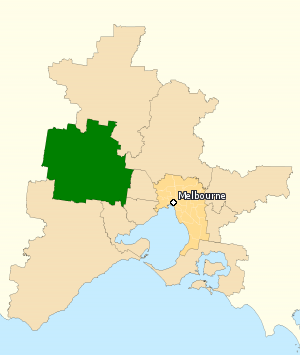Division of Ballarat
| Ballarat Australian House of Representatives Division | |
|---|---|
|
Division of Ballarat in Victoria, as of the 2016 federal election. | |
| Created | 1901 |
| MP | Catherine King |
| Party | Labor |
| Namesake | Ballaarat (from a Wathaurong Aboriginal word: balla arat, thought to mean "resting place".)[1] |
| Electors | 110,793 (2016) |
| Area | 4,652 km2 (1,796.1 sq mi) |
| Demographic | Provincial |
The Division of Ballarat (spelt Ballaarat from 1901 until the 1977 election[1]) is an Australian Electoral Division in the state of Victoria. It was named for the provincial city of the same name by Scottish squatter Archibald Yuille, who established the first settlement − his sheep run called Ballaarat − in 1837,[2] with the name derived from a local Wathaurong Aboriginal word for the area, balla arat, thought to mean "resting place". The division was one of the original 75 divisions contested at the first federal election.[1]
The division currently takes in the regional City of Ballarat and the smaller towns of Bacchus Marsh, Ballan, Blackwood, Buninyong, Clunes, Creswick, Daylesford, Myrniong and Trentham and part of Burrumbeet.
The current Member for Ballarat, since the 2001 federal election, is Catherine King, a member of the Australian Labor Party.
History
At various times in its existence the division has included other towns such as Ararat, Maryborough, and Stawell.
Ballarat is a marginal seat, changing hands at intervals between the Labor Party and the non-Labor parties. Its most prominent member has been Alfred Deakin, who was Prime Minister of Australia three times. Liberal senator Michael Ronaldson was the grandson of Archibald Fisken, a former Member for Ballarat.[3]
Ballarat also holds the distinction of seeing the closest seat result in Australian history. Nationalist Edwin Kerby unseated Labor incumbent Charles McGrath by a single vote in 1919. However, McGrath alleged irregularities, and the result was thrown out in 1920, forcing a by-election that was won by McGrath.[4]
Members
| Member | Party | Term | |
|---|---|---|---|
| Alfred Deakin | Protectionist | 1901–1909 | |
| Commonwealth Liberal | 1909–1913 | ||
| Charles McGrath | Labor | 1913–1919 | |
| Edwin Kerby | Nationalist | 1919–1920 | |
| Charles McGrath | Labor | 1920–1931 | |
| United Australia | 1931–1934 | ||
| Archibald Fisken | United Australia | 1934–1937 | |
| Reg Pollard | Labor | 1937–1949 | |
| Alan Pittard | Liberal | 1949–1951 | |
| Bob Joshua | Labor | 1951–1955 | |
| Labor (Anti-Communist) | 1955–1955 | ||
| Dudley Erwin | Liberal | 1955–1975 | |
| Jim Short | Liberal | 1975–1980 | |
| John Mildren | Labor | 1980–1990 | |
| Michael Ronaldson | Liberal | 1990–2001 | |
| Catherine King | Labor | 2001–present | |
Election results
| Party | Candidate | Votes | % | ± | |
|---|---|---|---|---|---|
| Labor | Catherine King | 42,275 | 43.27 | +1.36 | |
| Liberal | Sarah Wade | 33,931 | 34.73 | −3.27 | |
| Greens | Alice Barnes | 10,551 | 10.80 | +1.29 | |
| National | Paul Tatchell | 4,108 | 4.20 | +4.20 | |
| Christians | Dianne Colbert | 2,023 | 2.07 | +0.85 | |
| Family First | Graham Howard | 1,896 | 1.94 | +0.72 | |
| Independent | Bren Eckel | 1,802 | 1.84 | +1.84 | |
| Rise Up Australia | Tran Tran | 1,121 | 1.15 | +0.91 | |
| Total formal votes | 97,707 | 94.71 | −0.63 | ||
| Informal votes | 5,461 | 5.29 | +0.63 | ||
| Turnout | 103,168 | 93.12 | −1.80 | ||
| Two-party-preferred result | |||||
| Labor | Catherine King | 56,002 | 57.32 | +2.43 | |
| Liberal | Sarah Wade | 41,705 | 42.68 | −2.43 | |
| Labor hold | Swing | +2.43 | |||
References
- 1 2 3 "Profile of the electoral division of Ballarat (Vic)". Current federal electoral divisions. Australian Electoral Commission. 26 September 2013. Retrieved 22 November 2013.
- ↑ Buninyong monument. Ballarat Reform League. Retrieved on 18 August 2011.
- ↑ "House of Representatives: Voting by constituency, Victoria". Legislative election of 24 March 1990. Adam Carr. 1990. Retrieved 22 November 2013.
- ↑ "BALLARAT ELECTION VOID.". The Argus. Melbourne: National Library of Australia. 3 June 1920. p. 8. Retrieved 19 May 2014.
- ↑ Ballarat, VIC, Virtual Tally Room 2016, Australian Electoral Commission.
External links
Coordinates: 37°30′58″S 144°03′58″E / 37.516°S 144.066°E
